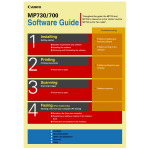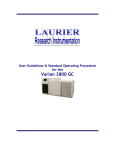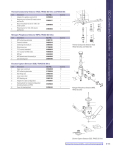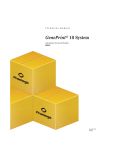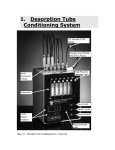Download The Troubleshooting and Maintenance Guide for Gas
Transcript
Dean Rood The Troubleshooting and Maintenance Guide for Gas Chromatographers Fourth, Revised and Updated Edition Dean Rood The Troubleshooting and Maintenance Guide for Gas Chromatographers 1807–2007 Knowledge for Generations Each generation has its unique needs and aspirations. When Charles Wiley first opened his small printing shop in lower Manhattan in 1807, it was a generation of boundless potential searching for an identity. And we were there, helping to define a new American literary tradition. Over half a century later, in the midst of the Second Industrial Revolution, it was a generation focused on building the future. Once again, we were there, supplying the critical scientific, technical, and engineering knowledge that helped frame the world. Throughout the 20th Century, and into the new millennium, nations began to reach out beyond their own borders and a new international community was born. Wiley was there, expanding its operations around the world to enable a global exchange of ideas, opinions, and know-how. For 200 years, Wiley has been an integral part of each generation’s journey, enabling the flow of information and understanding necessary to meet their needs and fulfill their aspirations. Today, bold new technologies are changing the way we live and learn. Wiley will be there, providing you the must-have knowledge you need to imagine new worlds, new possibilities, and new opportunities. Generations come and go, but you can always count on Wiley to provide you the knowledge you need, when and where you need it! William J. Pesce President and Chief Executive Officer Peter Booth Wiley Chairman of the Board Dean Rood The Troubleshooting and Maintenance Guide for Gas Chromatographers Fourth, Revised and Updated Edition The Author Dean Rood 968 Glide Ferry Way Drive Sacramento, CA 95831 USA All books published by Wiley-VCH are carefully produced. Nevertheless, authors, editors, and publisher do not warrant the information contained in these books, including this book, to be free of errors. Readers are advised to keep in mind that statements, data, illustrations, procedural details or other items may inadvertently be inaccurate. Library of Congress Card No.: applied for British Library Cataloguing-in-Publication Data: A catalogue record for this book is available from the British Library. Bibliographic information published by the Deutsche Nationalbibliothek The Deutsche Nationalbibliothek lists this publication in the Deutsche Nationalbibliografie; detailed bibliographic data are available in the Internet at http://dnb.d-nb.de. © 2007 WILEY-VCH Verlag GmbH & Co. KGaA, Weinheim All rights reserved (including those of translation into other languages). No part of this book may be reproduced in any form – by photoprinting, microfilm, or any other means – nor transmitted or translated into a machine language without written permission from the publishers. Registered names, trademarks, etc. used in this book, even when not specifically marked as such, are not to be considered unprotected by law. Typesetting Manuela Treindl, Laaber Printing Strauss GmbH, Mörlenbach Binding Litges & Dopf GmbH, Heppenheim Wiley Bicentennial Logo Richard J. Pacifico Printed in the Federal Republic of Germany Printed on acid-free paper ISBN 978-3-527-31373-0 V Preface Even though gas chromatography (GC) is considered a very mature and highly developed technology, advances continue to be made in the areas of hardware, electronics, software and columns. In some cases, these advances have reduced the occurrence of problems and made their detection easier and more certain. In other cases, greater complexity has been introduced with its own set of problems and solutions. Regardless of the age or complexity of the GC instrument, many of the same problems occur and the underlying causes are often the same. In addition, the guidelines and techniques used to care and maintain the instruments and columns are the same. With this thought in mind, much of the core information in this edition does not differ significantly from the previous one; however, there are a number of noteworthy additions and enhancements. The majority of the figures are new and improved especially in the injector and detector chapters. A complete section on pressure and flow programmable injectors has been added. Due to its popularity and specific requirements, an Appendix on high speed GC using small diameter columns is new to this edition. Column, hardware, carrier gas and sample considerations and issues are presented in a concise and direct format to ensure successful high speed GC applications. Finally, an extensive Appendix on the basics of quantitative GC is new and relatively unique. This Appendix covers important quantitation definitions, calibration curves, the selection and use of quantitation techniques such as internal and external standards, and several standard preparation techniques. Numerous examples are provided to aid in understanding. The information contained in this book encompasses nearly 25 years of in-depth experience in the field of GC along with the wisdom passed along from 1000’s of personal interactions with GC practitioners around the world. It is often practical information mixed with a touch of theory such as presented and discussed within these pages that most often proves to be the most useful and helpful. Sacramento, CA, March 2007 Dean Rood VII Contents Preface V Intentions and Introduction 1 1 Introduction to Capillary Gas Chromatography 3 1.1 1.2 1.3 1.3.1 1.3.2 1.3.3 1.3.4 1.3.5 1.4 1.5 1.5.1 1.5.2 1.6 1.6.1 1.6.2 1.6.3 What Is Gas Chromatography? 3 What Types of Compounds Are Suitable for GC Analysis? 3 The Basic Parts of a Gas Chromatograph 4 Gas Supply and Flow Controllers 4 Injector 5 Capillary Column and Oven 5 Detector 6 Data System 6 The Chromatogram 6 The Mechanism of Compound Separation 8 A Simple Description of the Chromatographic Process 8 A Detailed Description of the Chromatographic Process 9 Factors Affecting Separation 11 Stationary Phase 11 Compound Structure 12 Column Temperature 12 2 Basic Definitions and Equations 14 Why Bother? 14 Peak Shapes 14 Peak Width (W) 14 Peak Symmetry 14 Retention 16 Retention Time (tr) 16 Adjusted Retention Time (trc) 16 Retention Factor (k) 16 Retention Index (I) 18 Phase Ratio (E) 19 Distribution Constant (KC) 20 2.1 2.2 2.2.1 2.2.2 2.3 2.3.1 2.3.2 2.3.3 2.3.4 2.4 2.5 VIII Contents 2.5.1 2.5.2 2.6 2.6.1 2.6.2 2.6.3 2.6.4 2.7 2.8 2.9 2.10 2.11 KC and Column Dimensions 21 KC and Column Temperature 21 Column Efficiency 21 Number of Theoretical Plates (N) 22 Height Equivalent to a Theoretical Plate (H) 22 Effective Theoretical Plates (Neff) and Effective Plate Heights (Heff) 23 Precautions When Using Theoretical Plates 23 Utilization of Theoretical Efficiency (UTE%) 24 Separation Factor (D) 25 Resolution (R) 25 Trennzahl (TZ) 27 Column Capacity 28 3 Capillary GC Columns: Tubing 30 3.1 3.2 3.3 3.4 3.5 Fused Silica Capillary Columns 30 Fused Silica Tubing 30 Outer Coating 32 Other Tubing Materials 32 Polyimide Fused Silica Tubing Bending Stress 4 Capillary GC Columns: Stationary Phases 34 4.1 4.2 4.2.1 4.2.2 4.2.3 4.2.4 4.3 4.3.1 4.3.2 4.3.3 4.4 4.4.1 4.4.2 4.4.3 4.4.4 4.5 4.6 4.7 4.7.1 4.7.2 4.7.3 4.7.4 4.7.5 4.8 Stationary Phases 34 Types of Stationary Phases 35 Polysiloxanes or Silicones 35 Arylene-Modified Polysiloxanes 37 Polyethylene Glycols 37 Porous Layer Stationary Phases 38 Characteristics of Stationary Phases 39 Bonded and Cross-linked Stationary Phases 39 Stationary Phase Polarity 39 Stationary Phase Selectivity 40 Stationary Phase Interactions 41 Dispersion Interaction 41 Dipole Interaction 42 Hydrogen Bonding Interaction 43 When There are Multiple Interactions 44 Stationary Phase Equivalencies 45 Column Temperature Limits 46 Column Bleed 47 What is Column Bleed? 47 Measuring Column Bleed 48 Sensitivity Considerations 49 Detector Considerations 49 Minimizing Column Bleed 50 Selecting Stationary Phases 50 33 Contents 5 Capillary GC Columns: Dimensions 53 5.1 5.2 5.2.1 5.2.2 5.2.3 5.2.4 5.2.5 5.2.6 5.3 5.3.1 5.3.2 5.3.3 5.3.4 5.3.5 5.3.6 5.3.7 5.3.8 5.3.9 5.3.10 5.4 5.4.1 5.4.2 5.4.3 5.4.4 5.4.5 5.4.6 5.5 Introduction 53 Column Length 53 Column Length and Efficiency/Resolution 53 Column Length and Retention 57 Column Length and Pressure 57 Column Length and Bleed 58 Column Length and Cost 58 Selecting Column Length 58 Column Diameter 59 Column Diameter and Efficiency/Resolution 59 Column Diameter and Retention 62 Column Diameter and Pressure 62 Column Diameter and Bleed 63 Column Diameter and Capacity 63 Column Diameter and Carrier Gas Volume 64 Column Diameter and Injector Efficiency 64 Column Diameter and Breakage 65 Column Diameter and Cost 65 Selecting Column Diameter 65 Column Film Thickness 66 Column Film Thickness and Retention 66 Column Film Thickness and Efficiency/Resolution Column Film Thickness and Capacity 70 Column Film Thickness and Bleed 71 Column Film Thickness and Inertness 71 Selecting Column Film Thickness 72 Manipulating Multiple Column Dimensions 72 6 74 Carrier Gas and Capillary Columns 74 Linear Velocity versus Flow Rate 74 Controlling the Linear Velocity and Flow Rate 74 Van Deemter Curves 75 Carrier Gas Measurements 76 Average Linear Velocity (u) 76 Column Flow Rate 79 Carrier Gas Selection 80 Nitrogen 80 Helium 80 Hydrogen 82 Recommended Average Linear Velocities 83 Gas Purities 86 Common Carrier Gas Problems 87 6.1 6.2 6.3 6.4 6.5 6.5.1 6.5.2 6.6 6.6.1 6.6.2 6.6.3 6.7 6.8 6.9 Carrier Gas 69 IX X Contents 7 7.1 7.2 7.2.1 7.2.2 7.2.3 7.2.4 7.3 7.3.1 7.3.2 7.3.3 7.3.4 7.3.5 7.3.6 7.4 7.4.1 7.4.2 7.4.3 7.4.4 7.4.5 7.4.6 7.4.7 7.4.8 7.4.9 7.5 7.5.1 7.5.2 7.5.3 7.5.4 7.5.5 7.5.6 7.6 7.6.1 7.6.2 7.6.3 7.6.4 7.6.5 7.6.6 7.7 7.7.1 7.7.2 7.7.3 7.7.4 7.7.5 7.7.6 89 Introduction 89 The Basics of Vaporization Injectors 89 Injector Temperature 91 Speed of Sample Transfer 91 Injector Backflash 91 Injector Discrimination 94 Split Injectors 95 Description of a Split Injector 95 Split Ratio 96 Septum Purge for Split Injectors 99 Split Injector Liners 99 Column Position in Split Injectors 101 Common Problems with Split Injectors 102 Splitless Injectors 102 Description of a Splitless Injector 102 Selecting Purge Activation Times 105 Solvent Effect for Splitless Injectors 106 Cold Trapping for Splitless Injectors 108 Septum Purge for Splitless Injectors 108 Splitless Injection Liners 109 Column Position in Splitless Injectors 109 Other Aspects of Splitless Injectors 110 Common Problems with Splitless Injectors 111 Direct Injectors 112 Description of a Direct Injector 112 Direct Injection Liners 113 Septum Purge for Direct Injectors 115 Column Position in Direct Injectors 115 Other Aspects of Direct Injectors 115 Common Problems with Direct Injectors 116 Cool On-Column Injectors 117 Description of an On-Column Injector 117 Solvent Effect and Cold Trapping for Cool On-Column Injectors 118 Secondary Cooling 119 Retention Gaps and Cool On-Column Injectors 119 Other Aspects of Cool On-Column Injectors 120 Common Problems With On-Column Injectors 120 Pressure and Flow Programmable Injectors 121 Description of Programmable Injectors 121 Constant Pressure Mode 122 Constant Flow or Velocity Mode 122 Pressure Program Mode 123 Pulsed Pressure Mode 124 Gas Saver Mode 125 Injectors Contents 7.7.7 7.8 7.8.1 7.8.2 7.9 7.10 7.10.1 7.10.2 7.10.3 7.10.4 7.11 7.11.1 7.11.2 7.11.3 7.11.4 Other Aspects of Programmable Injectors 125 Injection Techniques 126 Syringe Filling Techniques 126 Injection Speed 128 Autosamplers 129 Injector Septa 131 Introduction 131 Septa Hardness 131 Septa Bleed 131 Handling Septa 133 Injector Maintenance 134 Cleaning Injectors 134 Injector Traps 135 Cleaning Injector Liners 135 Silylating Injector Liners 136 8 Detectors 139 8.1 8.2 8.2.1 8.2.2 8.2.3 8.2.4 8.2.5 8.2.6 8.3 8.3.1 8.3.2 8.3.3 8.3.4 8.3.5 8.3.6 8.3.7 8.3.8 8.3.9 8.3.9.1 8.3.9.2 8.3.9.3 8.3.9.4 8.4 8.4.1 8.4.2 8.4.3 8.4.4 8.4.5 Introduction 139 Detector Characteristics 139 Detector Dead Volume 139 Detector Makeup or Auxiliary Gas 140 Detector Temperature 141 Detector Sensitivity 142 Detector Selectivity 143 Detector Linear Range 144 Flame Ionization Detector (FID) 145 FID Principle of Operation 145 FID Gases 146 Column Position in a FID 147 FID Temperature 147 FID Selectivity 147 FID Sensitivity and Linear Range 147 Verifying Flame Ignition of a FID 148 FID Maintenance 148 Common Problems with a FID 149 Change in FID Sensitivity 149 Difficulty in Lighting the FID Flame 149 Peak Shape Problems Attributed to the FID 150 Miscellaneous Problems with a FID 150 Nitrogen-Phosphorus Detector (NPD) 151 NPD Principle of Operation 151 NPD Gases 152 Column Position in a NPD 152 NPD Temperature 153 NPD Selectivity 153 XI XII Contents 8.4.6 8.4.7 8.4.8 8.4.8.1 8.4.8.2 8.4.8.3 8.5 8.5.1 8.5.2 8.5.3 8.5.4 8.5.5 8.5.6 8.5.7 8.5.8 8.5.8.1 8.5.8.2 8.5.8.3 8.5.8.4 8.5.8.5 8.5.8.6 8.6 8.6.1 8.6.2 8.6.3 8.6.4 8.6.5 8.6.6 8.6.7 8.6.8 8.6.8.1 8.6.8.2 8.6.8.3 8.6.8.4 8.6.8.5 8.7 8.7.1 8.7.2 8.7.3 8.7.4 8.7.5 8.7.6 8.7.7 8.7.8 8.7.9 NPD Sensitivity and Linear Range 153 NPD Maintenance 154 Common Problems with a NPD 155 Change in NPD Sensitivity 155 Peak Shape Problems Attributed to the NPD 155 NPD Baseline Problems 156 Electron Capture Detector (ECD) 157 ECD Principle of Operation 157 ECD Gases 158 Column Position in an ECD 158 ECD Temperature 159 ECD Selectivity 159 ECD Sensitivity and Linear Range 160 ECD Maintenance 160 Common Problems with an ECD 161 Change in ECD Sensitivity 161 Peak Shape Problems Attributed to the ECD 162 ECD Baseline Problems 162 Negative Peaks with an ECD 163 ECD Linear Range Problems 163 Miscellaneous Problems with an ECD 163 Thermal Conductivity Detector (TCD) 164 TCD Principle of Operation 164 TCD Gases 165 Column Position in a TCD 166 TCD Temperature 166 TCD Selectivity 166 TCD Sensitivity and Linear Range 166 TCD Maintenance 167 Common Problems with a TCD 168 Change in TCD Sensitivity 168 Peak Shape Problems Attributed to the TCD 169 TCD Baseline Problems 169 Negative Peaks with a TCD 170 Short TCD Filament Lifetimes 170 Flame Photometric Detector (FPD) 170 FPD Principle of Operation 170 FPD Gases 171 Column Position in a FPD 172 FPD Temperature 172 FPD Selectivity 172 FPD Sensitivity and Linear Range 172 Verifying Flame Ignition of a FPD 173 FPD Maintenance 173 Common Problems with a FPD 174 Contents 8.7.9.1 8.7.9.2 8.7.9.3 8.7.9.4 8.7.9.5 8.8 8.8.1 8.8.2 8.8.3 8.8.4 8.8.5 8.8.6 8.8.7 8.8.8 8.8.9 8.8.10 8.8.10.1 8.8.10.2 8.8.10.3 Change in FPD Sensitivity 174 Peak Shape Problems Attributed to the FPD 174 Loss of FPD Linear Range 175 FPD Flame Frequently Goes Out 175 Miscellaneous Problems with a FPD 175 Mass Spectrometers (MS) 175 MS Principle of Operation 175 Mass Spectral Data 177 Other Ionization, Detection and Mass Filtering Modes 178 MS Selectivity 179 MS Sensitivity and Linear Range 179 MS Temperatures 180 Column Position in a MS 181 Carrier Gas Flow Rate Considerations for MS Detectors 181 MS Maintenance 182 Common Problems with a MS 183 Change in MS Sensitivity 183 Excessive Noise or High Background in a MS 184 Leaks in the MS 185 9 Column Installation 186 9.1 9.2 9.2.1 9.2.2 9.2.3 9.2.4 9.2.5 9.2.6 9.2.7 9.2.8 9.2.8.1 9.2.8.2 9.2.8.3 9.2.8.4 9.2.9 9.2.10 9.2.11 9.3 9.4 9.5 9.6 Importance of a Properly Installed Column 186 Installing Fused Silica Capillary Columns 186 Column Installation Steps 186 Cutting Fused Silica Capillary Columns 187 Column Placement in the GC Oven 187 Column Installation in the Injector 188 Turning On and Verifying the Carrier Gas Flow 189 Column Installation in the Detector 189 Verifying Proper Column Installation and Detector Operation 190 Column Conditioning 192 What is Column Conditioning? 192 Conditioning Temperatures 192 Conditioning the Column While Connected to the Detector 192 Conditioning the Column While Disconnected from the Detector 194 Setting the Carrier Gas Average Linear Velocity 195 Bleed Test 195 Injecting Column Test Sample 196 Column Ferrules 198 Tightening Fittings 199 Techniques for Measuring Column Insertion Distances 200 Leak Detection 201 10 Column Test Mixtures 202 Column Performance Testing 10.1 202 XIII XIV Contents 10.2 10.2.1 10.2.2 10.2.3 10.2.4 10.2.5 10.3 10.3.1 10.3.2 10.3.3 10.3.4 10.4 10.5 10.6 Column Test Mixture Compounds 203 Hydrocarbons 203 Alcohols 203 Acids and Bases 204 FAMEs 204 Other Compounds 205 Column Testing Conditions 205 Injectors 205 Detectors 205 Column Temperature 206 Test Sample Concentration 206 Grob Test 207 Own Test Mixture 208 When to Test a Column 209 11 Causes and Prevention of Column Damage 210 11.1 11.2 11.2.1 11.2.2 11.2.3 11.2.4 11.3 11.3.1 11.3.2 11.3.3 11.3.4 11.4 11.4.1 11.4.2 11.4.3 11.4.4 11.5 11.5.1 11.5.1.1 11.5.1.2 11.5.1.3 11.5.1.4 11.5.2 11.5.3 11.5.4 11.6 11.6.1 11.6.2 11.6.3 Causes of Column Damage and Performance Degradation 210 Column Breakage 210 Causes of Column Breakage 210 Symptoms of Column Breakage 211 Prevention of Column Breakage 211 Recovery from Column Breakage 211 Thermal Damage 212 Causes of Thermal Damage 212 Symptoms of Thermal Damage 212 Prevention of Thermal Damage 213 Recovery from Thermal Damage 213 Oxygen Damage 213 Causes of Oxygen Damage 213 Symptoms of Oxygen Damage 214 Prevention of Oxygen Damage 214 Recovery from Oxygen Damage 214 Chemical Damage 214 Causes of Chemical Damage 214 Bases 215 Acids 215 HCl and NH4OH 216 Organic Solvents and Water 216 Symptoms of Chemical Damage 217 Prevention of Chemical Damage 217 Recovery from Chemical Damage 218 Column Contamination 218 Causes of Column Contamination 218 Symptoms of Column Contamination 220 Prevention of Column Contamination 221 Contents 11.6.4 11.7 11.7.1 11.7.2 11.7.3 11.7.4 11.8 11.8.1 11.8.2 11.8.3 11.8.4 11.9 11.10 11.11 11.12 Recovery from Contamination 221 Solvent Rinsing Columns 222 Solvent Rinse Kits 222 Solvent Selection, Volumes and Flow Rates 224 Conditioning the Column After Solvent Rinsing 225 Some Solvent Rinsing Considerations 226 Guard Columns and Retention Gaps 226 Deactivated Fused Silica Tubing 226 Guard Columns 227 Retention Gaps 227 Unions 228 Packed Injector Liners 230 Gas Impurity Traps 230 Column Storage 232 Column Repair 232 12 Troubleshooting Guidelines, Approaches and Tests 233 12.1 12.2 12.2.1 12.2.2 12.2.3 12.2.4 12.2.5 12.2.6 12.2.7 12.2.8 12.2.9 12.3 12.4 12.4.1 12.4.2 12.4.3 12.4.4 12.4.5 12.4.6 Introduction 233 Approaches to Solving GC Problems 234 Systematic Approach 234 Checking the Obvious 234 Looking for Changes 235 Looking for Trends, Patterns and Common Characteristics 235 Asking “If … Then …” Questions 236 One Thing at a Time 236 Moving from the General to the Specific 236 Eliminating the Possibilities 237 Divide and Conquer 237 Troubleshooting Tools 238 Troubleshooting Tests 239 Jumper Tube Test 239 Condensation Test 240 Check Out Column 240 Column Exchange 241 Static Pressure Check 241 Column Test Samples 242 13 Common Capillary GC Problems and Probable Causes 243 13.1 13.2 13.3 13.3.1 13.3.2 13.3.3 13.4 Using This Troubleshooting Guide 243 Troubleshooting Checklist and Pre-Work 243 Baseline Problems 245 Baseline Drift or Wander 245 Noisy Baseline 246 Spikes in the Baseline 246 Peak Shape Problems 247 XV XVI Contents 13.4.1 13.4.2 13.4.3 13.4.4 13.5 13.6 13.7 13.8 13.9 13.9.1 13.9.2 13.10 13.10.1 13.10.2 13.10.3 13.11 13.12 13.13 Tailing Peaks 247 Fronting Peaks 249 Extremely Broad or Rounded Peaks 250 Flat Top Peaks 250 Split Peaks 251 Negative Peaks 252 Excessively Broad Solvent Front 253 Loss of Resolution 254 Retention Changes 254 Retention Time (tr) Change Only 254 Retention Factor (k) Change 255 Peak Size Problems 256 No Peaks 256 All Peaks Change in Size 256 Some Peaks Change in Size or Missing Peaks Extra or Ghost Peaks (Carryover) 258 Rapid Column Deterioration 259 Quantitation Problems 260 257 Appendix A Terms 261 Appendix B Equations 263 Appendix C Mass, Volume and Length Unit Conversions 266 Appendix D Column Bleed Mass Spectra 267 273 Introduction 273 Column Considerations 273 Carrier Gas Considerations 274 Injector Considerations 275 Detector and Data System Considerations 276 GC Oven Considerations 276 Sample Considerations 277 An Example of High Speed GC Using a Small Diameter Column 277 High Speed GC Summary 279 Appendix E The Basics of High Speed GC Using Small Diameter Columns E.1 E.2 E.3 E.4 E.5 E.6 E.7 E.8 E.9 Appendix F Basic Quantitative Capillary GC 280 F.1 F.2 F.3 F.3.1 F.3.2 F.3.3 Intentions 280 Definitions 280 Concentration 282 Weight-to-Weight (w/w) and Weight-to-Volume (w/v) 282 Parts per Million (ppm) and Parts per Billion (ppb) 283 Percent (%) 284 Contents F.3.4 F.4 F.5 F.5.1 F.5.2 F.6 F.6.1 F.6.2 F.6.3 F.6.4 F.7 F.7.1 F.7.2 F.7.2.1 F.7.2.2 F.7.3 F.7.3.1 F.7.3.2 F.7.3.3 F.7.4 Molarity (M or mM) 284 Density (U) 285 Calibration for Quantitative Purposes 286 Single and Multiple Point Calibration 286 Calibration Curves 287 Quantitation Calculations 289 External Standard 289 Internal Standard 291 Modified Standard Addition 295 Relative Percent 296 Techniques for Preparation of Analytical Standards for GC 297 Standard Composition Considerations 297 Preparing One Component Standards 299 Using a Volumetric Flask 299 Using Vials and an Exact Measurement Technique 302 Preparing Multi-Component Standards 304 Equal Volume Method 304 Equal Concentration Method 306 Unequal Volume and Unequal Concentration Method 309 Serial Dilution 311 References 317 Subject Index 319 XVII 1 Intentions and Introduction There already seems to be a number of excellent references on gas chromatography (GC), so why this book? Well, there are several reasons. There is a large number of gas chromatographs in use. If is often stated that gas chromatography is the most common instrumental analytical technique in routine use. The availability of easy to operate, affordable and feature laden instruments has made GC a powerful analytical technique accessible to nearly every laboratory. Commercially available capillary columns of high quality have existed for about 25 years. For a number of reasons, many GC users are not extremely experienced in the practice of capillary gas chromatography. Many of these users do not possess a level of comprehension of the technique that allows them to prevent and solve many of the problems that commonly occur. Much of this comprehension comes from years of experience and the problems that accompany that experience. The combination of accessible instruments and capillary columns along with inexperienced users has created the need for practical information on the care, maintenance and troubleshooting of capillary columns and instruments. One of the goals of this book is to provide practical information that will maximize both capillary column lifetime and the performance of the gas chromatographic system. The other goal is to provide an efficient and logical troubleshooting guide with the real intention to reduce or prevent performance breakdown problems from occurring. An in-depth knowledge of chemistry and chromatography (and other foreign languages) is not required. This book, in no shape or form, attempts to thoroughly explain every detail about capillary gas chromatography; it is intended as a practical guide so that the urge to hit the GC with a hammer as a last resort does not occur. In-depth technical information about GC techniques, instrumentation, specific applications and other gory details can be found in the books listed in the reference section. Many generalizations and simplifications have been exercised to keep the information in a basic and widely digestible form. Again, this book is intended for the average GC user and not those whose entire life revolves around capillary gas chromatography. The topics covered within these pages are based on the most common problems, questions and misconceptions about capillary gas chromatography. These topics have been assembled and presented in an unique, practical and concise format suitable even for the most inexperienced GC user. 2 Intentions and Introduction References to specific models of GCs and columns from specific manufacturers have been avoided where possible. Any differences are usually minor and often inconsequential in nature. The operating principles, proper techniques and practices, and underlying theory are the same regardless of the instrument or column manufacturer. 3 1 Introduction to Capillary Gas Chromatography 1.1 What Is Gas Chromatography? In a broad sense, gas chromatography is a very powerful and one of the most common instrumental analysis techniques in use. When properly utilized, it provides both qualitative (i.e., what is it?) and quantitative (i.e., how much?) information about individual components in a sample. Gas chromatography involves separating the different compounds in a sample from each other. This allows the easy identification and measurement of the individual compounds in a sample. The compounds are separated primarily by the differences in their volatilities and structures. Many compounds and samples are not suitable for gas chromatographic analysis due to their physical and chemical properties. 1.2 What Types of Compounds Are Suitable for GC Analysis? For a compound to be suitable for GC analysis, it must possess appreciable volatility at temperatures below 350–400 °C. In other words, all or a portion of the compound molecules have to be in the gaseous or vapor state below 350–400 °C. Another characteristic is the compound must be able to withstand high temperatures and be rapidly transformed into a vapor without degradation or reacting with other compounds. Unfortunately, this type of information about a compound is not readily available in references or other sources; however, some estimates and generalizations can be made from the structure of the compounds. Compound structure and molecular weight can be used as indicators of potential GC analysis suitability. Compounds with very low volatilities are not suited for GC analysis since they do not readily vaporize. Compound boiling points are not always good indicators of volatility. There are many high boiling compounds that can be analyzed by GC. As a general rule, the greater the molecular weight or polarity of a compound, the lower its volatility. Both factors have to be considered. For example, a large, non-polar compound may be more volatile than a small, polar compound. Also, one polar group on a large molecule has less of an influence than one polar group on a small molecule. 4 1 Introduction to Capillary Gas Chromatography Hydrocarbons with molecular weights over 500 are routinely analyzed using standard GC systems, and hydrocarbons with molecular weights over 1400 have been easily analyzed using the properly equipped GC and type of column. The presence of polar functionalities such as hydroxyl and amine groups severely decrease compound volatility. Some small molecules such as sugars and amino acids can not be easily analyzed by GC due to the large number of polar groups. As a rule, inorganic compounds are not suitable for GC analysis. Metals and salts do not possess the required volatility. Many organo-metallics have sufficient volatility for analysis due to the high organic content of these molecules. Most organic compounds are suitable for GC analysis; however, there are many exceptions. Many biomolecules and pharmaceuticals are thermally sensitive and degrade at the temperatures used in gas chromatography. Some compounds react with the materials used in gas chromatographs and columns and can not successfully analyzed by GC. There are no realistic, absolute guidelines that can be used to determine whether a compound can be analyzed by GC. Overall, it has been estimated that only about 10% of all compounds can be analyzed by GC. 1.3 The Basic Parts of a Gas Chromatograph A gas chromatographic system is comprised of six major components: gas supply and flow controllers, injector, detector, oven, column, and a data system (Figure 1-1). In most cases, the injector, detector and oven are integral parts of the gas chromatograph; the column, gases and recording device are separate items and are often supplied by a different manufacturer. All of the components are further described in individual sections or chapters with the exception of the oven and recording devices. 1.3.1 Gas Supply and Flow Controllers High purity gases are supplied from a pressurized cylinder or gas generator. Pressure regulators on the cylinders or generators control the amount of gas delivered to the gas chromatograph. Flow controllers or pressure regulators in the gas chromatograph control the flow of the various gases once they enter the instrument. The column is installed between the injector and detector. Gas at a precisely controlled flow is supplied to the injector; this gas is called the carrier gas. The carrier gas flows through the injector and into the open tubular column. The gas travels the length of the column and exits through a detector. To function as desired, most detectors require specific gases at the proper flow rates. 1.3 The Basic Parts of a Gas Chromatograph Figure 1-1 Block diagram of a typical gas chromatograph. Solid arrows denote gas flow paths and dotted arrows denote electronic signal flow paths. 1.3.2 Injector The injector introduces the sample into the open tubular column. The injector is a hollow, metal cylinder containing a glass liner or insert. The column is inserted into the bottom of the injector so that the column end resides in the lower region of the glass liner. A liquid, or sometimes a gas, is introduced into the injector through a resealable septum using a small syringe. The injector is heated to 100–300 °C, thus any volatile sample components are rapidly transformed into a vapor. The carrier gas mixes with the vaporized portion of the sample and carries the sample vapors into the column. An on-column injector deposits the sample directly into the column without a vaporization step and it is used for select types of samples. In some cases, nonsyringe techniques utilizing specialized equipment or devices (e.g., purge and trap, headspace, and valves) can be used to introduce a sample into a column. 1.3.3 Capillary Column and Oven The column resides in an oven whose temperature is accurately controlled. If unimpeded, vaporized compounds move through the column at the same rate as the flowing carrier gas. However, the interior walls of columns are coated 5 6 1 Introduction to Capillary Gas Chromatography with a thin film of polymeric material called the stationary phase. This stationary phase impedes the movement of each compound down the column by a different amount. This behavior is called retention. The length and diameter of the column, the chemical structure and amount of the stationary phase, and the column temperature all affect compound retention. If all of these factors are properly selected, each compound travels through the column at a different rate. This makes the compounds exit the column at different times. As each compound leaves the column, its presence and amount are measured by the detector. 1.3.4 Detector As each compound exits the column, it enters the detector. The detector interacts with the compounds based on some physical or chemical property. Some detectors respond to every compound while others respond only to a select group of compounds. The interaction generates an electrical signal whose size corresponds to the amount of the compound. The detector signal is then sent to a recording device for plotting. 1.3.5 Data System The recording device plots the size of the detector signal versus the time elapsed since sample introduction into the injector. The plot is called a chromatogram and appears as a series of peaks (Figure 1-2). Except very old recorders, some type of report is provided by the data system. The most common data recording devices are computer (PC) based. Older GC systems may use an integrator or a strip chart recorder which produce printed versions of the chromatogram and report with little or no data storage and recall capability. PC based data system are extremely powerful and offer numerous data plotting, reporting and storage options, thus their popularity. Most computer data system can also control and automate the operation of the GC. 1.4 The Chromatogram In the ideal situation, each peak in the chromatogram represents a single compound in the sample. It is not unusual for more than one compound in a sample to interact with the column in the same manner, thus each compound has the same retention. This results in a single peak that represents more than one compound (complete co-elution). In some cases, the interactions are very similar, but not identical. This results in two peaks that partially overlap (partial co-elution). Using the proper column and operating conditions minimizes dual 1.4 The Chromatogram Retention Time 1.074 1.164 1.756 2.015 2.471 2.611 3.008 3.063 4.299 4.790 5.356 5.431 6.424 Area 19485 36605766 12011 17933 24445 405 20025 9160 36815 36378 31780 396 40605 Height 38020 36035875 14998 18513 23052 282 15747 7206 19872 17617 13923 178 14352 Width 0.0084 0.0167 0.0133 0.0153 0.0164 0.0224 0.0196 0.0204 0.0288 0.0329 0.0354 0.0340 0.0402 Figure 1-2 Chromatogram and report. peak identities or overlapping problems, but there are cases where complete separation is not possible. Each peak in the chromatogram is assigned a retention time. It is the time required for a compound to travel through the column. The data system usually calculates and prints the retention times and size for each peak on the chromatogram or in a table (Figure 1-2); additional information may also be included in the report table. Retention times are usually reported in minutes and the peak size in an unitless area or height value. Identifying the compounds corresponding to each peak in the chromatogram is accomplished by comparison to a previously generated reference chromatogram. A prepared solution containing known amounts of each compound (commonly called a standard) is analyzed to obtain their respective retention times and peak 7 8 1 Introduction to Capillary Gas Chromatography sizes. Using the same column and GC parameters, the sample is analyzed. If any of the peaks in the sample have the same retention times as those in the standard, there is a good probability that the sample contains one or more of the compounds. If the peaks in the sample do not correspond to those in the standard, the sample does not contain any of the compounds. To determine the amount of a compound in the sample, the size of its peak is used. The size of a peak is proportional to its amount in the sample or standard. Since the standard contains a known amount of each compound, the peak sizes can be used as a reference. The size of the peak in the sample is compared to the size of the corresponding peak in the standard. A simple ratio is set up for quantitation. For example, if the peak in the sample is two times larger than the peak in the standard, the injected portion of the sample contains two times the amount of the compound than the amount known to be present in the standard. There are numerous situations where peak misidentification or quantitation errors can occur. Adhering to good GC practices will minimize the occurrence of these types of errors. Additional information on quantitative GC can be found in Appendix F. 1.5 The Mechanism of Compound Separation How does the column work? What happens inside the column? How do the compounds move through the column? Why do some compounds stay in the column longer than others? How does the sample get into the column? These are some of the most basic questions asked about gas chromatography. Knowing the answers does not automatically make a chromatographer produce better results, but the knowledge is very valuable in solving and preventing problems, selecting columns, and understanding unexpected results. Complicated discussions involving thermodynamics and molecular interactions are necessary to fully answer these questions. Fortunately, comprehension at this level is not necessary to become an excellent chromatographer. A basic understanding of the concepts, and not the intricate details, provides a chromatographer with all of the information necessary to produce the most consistent, trouble free and best results. 1.5.1 A Simple Description of the Chromatographic Process The separation of a sample into its individual compounds by a capillary GC column can be described by a very simple concept. The sample containing a mixture compounds enters the column and collects in the front of the column (Figure 1-3a). Then the molecules of each compound start to collectively move down the column at a different rate (Figure 1-3b). The fastest moving molecules reach the end of the column first, enters the detector, thus corresponding with the first peak in the chromatogram (Figure 1-3c). The next fastest compound molecules follows, 1.5 The Mechanism of Compound Separation Figure 1-3 Separation of the sample in the column. and this process continues until all of the remaining compounds have left the column (Figure 1-3d). Since the compounds each leave the column at different times, they are separated. Any compounds that travel through the column at the same rate are not separated and have the same retention times. 1.5.2 A Detailed Description of the Chromatographic Process Capillary columns are composed of three distinct parts. The tubing is fused silica (glass) with an outer protective coating. The inner walls are coated with a thin film of polymeric material called the stationary phase. The sample compounds interact with the stationary phase, and this interaction is responsible for the separation properties of the column. Once in the column, the molecules for each compound distribute between the mobile phase (carrier gas) and the stationary phase (Figure 1-4a). Molecules in the mobile phase move down the column; molecules in the stationary phase do not move down the column (Figure 1-4b). The carrier gas transports the compound molecules down the column. Simultaneously, the molecules are moving in a random motion. Eventually, each molecule comes into contact with the stationary phase. Each one enters the stationary phase when this occurs. For every molecule entering the stationary phase, another one leaves the stationary phase to take 9 10 1 Introduction to Capillary Gas Chromatography Figure 1-4 Movement of molecules down the column. Longitudinal cross-section view of a column. its place in the mobile phase (Figure 1-4c). This maintains the same overall distribution of the molecules between the two phases. The process of exchange between the phases is repeated thousands of times for each molecule. The net effect is the movement of the molecules down the column (Figure 1-4d). The rate of molecule movement down the column depends on the distribution of the molecules between the stationary and mobile phases. The greater the percentage of molecules in the mobile phase, the faster the molecules travel down the column. This results in a short residence time for the molecules in the column and a short retention time for the corresponding peak. Separation of two compounds occurs when the distribution of their molecules between the stationary and mobile phases are different. If the distributions are the same, coelution occurs. The distance or time between the various groups of molecules (with each group representing one compound) as they exit the column determines the amount of separation between the peaks. While this separation distance is important, there is more to chromatography than just separation. The length of column occupied by the molecules for each compound is critical. A narrow band of compound molecules occupying a short length of column is desired. If the width of the molecule bands is narrow, a large separation between the band of molecules is not needed to prevent overlap of the different compound molecules (Figure 1-5a). If the width of the molecule bands is broad, the same amount of separation results in an overlap of the different compound molecules (Figure 1-5b). When the molecule bands are broad, greater separation is need to prevent overlapping of the molecule bands (Figure 1-5c).






























